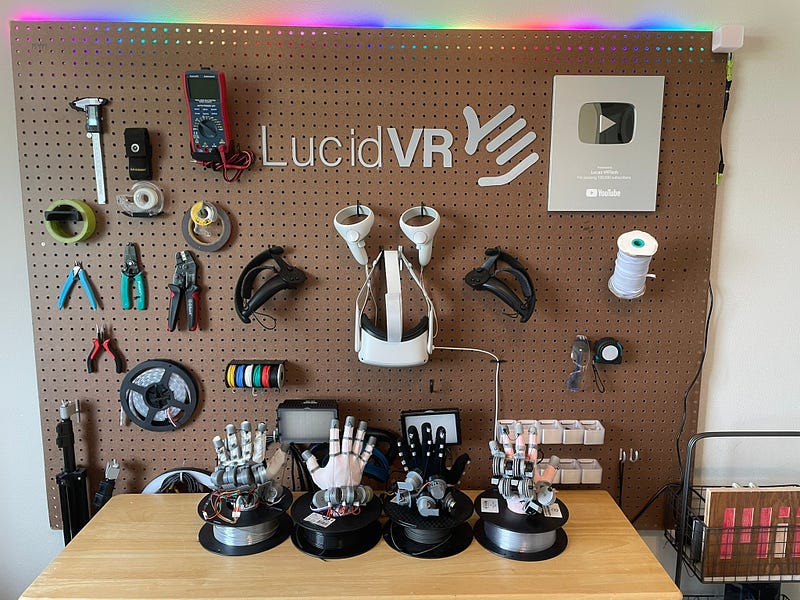The Haptics club is an Open community about #Haptics. Founded by members of Unity, Interhaptics, Senseglove, and Nanoport. An event every other week with speakers from various industries and academia.
Do you want to listen to the full podcast?
Who are Lucas De Bonet and LucidVR?
Lucas De Bonet has been working on a “Do It Yourself” VR haptic glove project for fun, and it got a lot of attention on the internet. The will to make VR haptic gloves accessible and affordable for everybody is what made him go into VR haptics. Therefore, he decided to build it by himself. After the huge success online, he decided to do it not just for himself but for everybody. He made it open-source and came up with four different prototypes.
After the success of his project on social media, Lucas was offered an internship position by Contact CI. Currently, the VR haptic gloves market is mainly enterprise-oriented, and by creating an open-source project, Lucas De Bonet is opening it to a broader audience.
How does the community respond to this project?
Most of Lucas’s community is more gaming-oriented than haptic-oriented. His end goal is to get the gloves working in the gaming environment. The finger-tracking is already compatible with most games on the SteamVR platform. However, the haptic feedback will be slightly more challenging. Overall, the communities are positive and quite excited about being able to extend their haptics experience.
How do you make sure to meet people’s expectations regarding the haptic feedback experience in itself?
Very few demos have been organized for people to try Lucas’s gloves, mostly because of the sanitary situation. The main aspect of haptics with the fourth prototype is the force feedback on each finger. It can restrict your hands’ position and tilt back at your fingers a little bit. The objective is to explore the possibilities of the haptics field even more by adding more features from the community.

How do the haptic gloves work?
When you open and close your fingers, the spool rotates, and it has a little screw sticking out and rotating left and right. This is the part that is blocked out when needed to produce the haptic feedback and feel the sensations related to the experience. The screw also rotates backward enough to make you feel that something is pushing against it without creating any pain.
What are the key experiences targeted by this project?
A lot of different VR games involve picking up and throwing objects or using them in a particular way, and it brings the experience to a whole other level being able to feel the actual curvature of the object in your hand, thanks to haptic feedback and not just grabbing it using the finger tracking.
Another great example is shooter games. When you pull the trigger, you can physically close your index finger to pull it.

The future of LucidVR
The main goal is to get people involved in the creation of VR materials. Many soon-to-be engineers are interested in developing and building these designs and want to understand what companies are doing to make them more accessible. This is the way to move forward in this industry.
It would be the greatest accomplishment to give people who cannot afford these technologies the opportunity to work on them.https://www.interhaptics.com/media/1d19cb6eade925241729bb6a8617bc6c
All the resources and guides are publicly available, and Lucas started a YouTube Tutorial series to show the full process.
Advice on how to leverage social media to grow online communities
Lucas started by creating Tik Tok videos, and this is how he was able to build interest and grow a community around his project. The big part of growing a community is finding your appropriate audience who would be excited by your content. It was quite easy to build interest in “Cheap VR gloves” because people were willing to try some after watching Ready Player One. They would not have had the chance to otherwise. After figuring out who your audience is, you need to determine how to reach out to it.
Who is the Haptics Club?
The Haptics Club was founded by Manuel Sainsily from Unity, Ashley Huffman from Nanoport, Gijs den Butter and Irina Tripapina from Senseglove, and Eric Vezzoli and Sarah Alkibsy from Interhaptics.
Follow the Haptics Club on Twitter and LinkedIn to stay updated with the next events.
Who is Interhaptics?
Interhaptics is a software company specialized in haptics. Interhaptics provides hand interactions and haptic feedback development and deployment tools for virtual reality (VR), mixed reality (MR), mobile, augmented reality (AR), and console applications. Interhaptics’ mission is to enable the growth of a scalable haptics ecosystem. Interhaptics strives to deliver top-notch development tools for the VR/MR/AR, mobile, and console developer community, and the interoperability of haptics-enabled content across any haptics-enabled platform.







